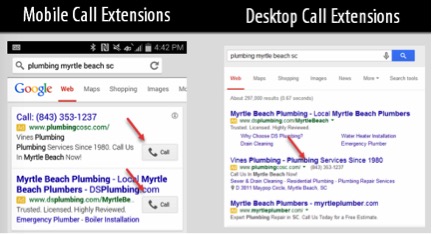Paid Search Marketers are always looking for a way to boost overall click thru rates within their accounts. While many metrics play a role in overall performance, higher click thru rates mean more traffic, which potentially leads to more conversions, leads or whatever you deem as a success within your account. Not only do higher click thru rates lead to more successful actions, but they also help to improve overall quality scores, leading to more cost-efficient traffic and lower CPCs.
So what can you do to improve CTRs within your account? You should already have a creative ad testing cycle in place to consistently be testing new messaging in your account. Beyond that, taking advantage of all the various ad extensions is crucial in providing potential customers the ultimate experience on the Search Engine Results Page and improving performance within your account. In this article, we’ll be diving into some of the most popular ad extension options within Google and some best practices to ensure you’re taking advantage.
Let’s get started!
Sitelinks Extensions
Sitelinks extensions are typically the most commonly used ad extension within PPC. They’re laid out to provide additional landing page options within the ad copy for potential consumers. What you can and probably should do is structure your sitelinks extensions to mimic the different tabs on your website. If that doesn’t make sense for your products or services, another option would be to structure them with the most popular landing pages on your website.
No matter how you structure your sitelinks extensions, you should be taking advantage of the “enhanced sitelinks”, which allows to you write individual descriptions for each sitelink, and ultimately appear as mini ads for each one. Below you can see an example of enhanced sitelinks and how they look on the Search Engine Results Page (SERP). Implementing enhanced sitelinks helps to own more real estate on the SERP.

Call Extensions
Call extensions are an excellent option for any PPC account that relies heavily on conversions through phone leads. Any product that has urgency from a consumer perspective would be a great fit for implementation.
By adding Google forwarding numbers to your call extensions, you’ll be able to track overall performance from calls you receive through the extensions, including specific details such as call duration, start and end time, and area code of user. With this level of information, you’ll then be able to analyze phone lead performance from various perspectives and optimize your campaigns accordingly.
If your business is reliant on phone leads or phone sales, you may want to consider tailoring your PPC campaigns to mimic the hours your call center is in operation. While showing your ads 24/7 is great, if you’re looking to be more cost-efficient and generate a lower CPA, this may be the route for you.
Below is an example of what call extensions look like on both desktop and mobile.

This extension is not to be confused with the new call-only campaigns.
Callout Extensions
Callout extensions is another option to help boost overall CTR and include additional messaging in your ad copy. This type of extension is typically used for quick shout out messages to potential consumers. Whether it be a promotion currently going on or a company accreditation that makes you stick out from the competition, it’s quick and easy to set up and should be taken advantage of. Remember, callout extensions are not clickable so keep that in mind when you’re implementing within your campaigns. Below you’ll see an example of callout extensions highlighted in the red box.

Location Extensions
For brick and mortar businesses, location extensions are an ideal option for your PPC account. The location extension includes a business address, phone number and a map. On mobile, this will include a link with directions to your business. This feature will help potential consumers to quickly find your business and the easiest possible way to get there as soon as possible.
Historically, ads have seen a boost of around 10% in CTR when location extensions are appended. That large of a spike in CTR shows how much user intent jumps when they see your business is nearby and accessible. Remember, if you have multiple locations you can add them within your location extensions. You can also link your account to Google My Business if you currently have an account there.
Below is an example of what a location extension may look like.

Conclusion
The main ad extensions highlighted in this article should help you find ways to improve your front-end metrics within your account. Depending on the goals of your particular account, you’ll be able to pinpoint the ad extensions that work best for you and help you grow.
Finding new ways to boost click-thru rates within your account is always a never-ending task for PPC marketers. While many factors play into this objective, expanding upon your ad copy with ad extensions is an excellent way to not only improve the overall experience for potential customers, but also to increase CTR, lower CPCs, and boost quality scores within the account. Ultimately improving these metrics leads to improvement in overall account performance.



